19+ Webinar Statistics & Benchmarks (2024 Stats + Data)
How popular are webinars? And should you use them for your business?
Webinar statistics help us better understand how marketers, businesses, and individuals consume webinar content.
In this post, we’re digging into the latest webinar statistics you need to know. You can use this data to understand when you should run webinars, how long your webinars should be, and more.
Editor’s picks
- 39% of B2B marketers use webinars. (Content Marketing Institute)
- Thursday is the most popular day to hold webinars. (MegaMeeting)
- The ideal webinar length is 60 minutes. (WorkCast)
- 86% use webinars for marketing. (ON24 Webinar Benchmarks Report)
- 37% don’t use webinars because of time constraints. (BrightTalk)
Webinar usage statistics
These are webinar consumer behavior statistics that give us an idea of how many people use webinar software and how they use them.
These webinar stats also include data on the best times to use webinar software.
The use of webinars increased by 390% in April 2020.
39% of B2C marketers are using webinars, online courses, and virtual events in 2020. This is up from the previous year’s number which was 27%.
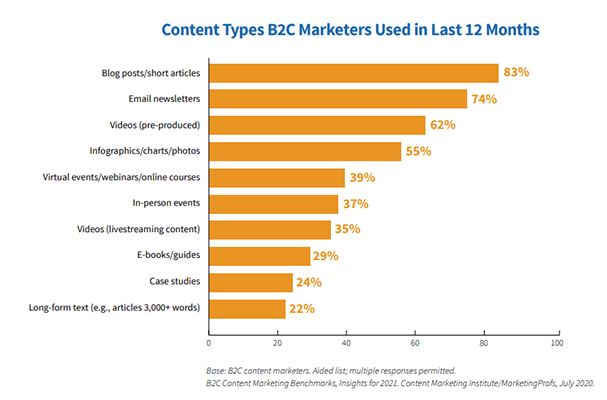
Another source noted that the pandemic caused a surge in content production as people started using webinars to engage others. BrightTalk saw an increase of 390% in April 2020 alone.
LinkedIn also noted in their webinar statistics study that marketers have shifted to webinars during the pandemic. This is why the use of webinars is up by 67% in 2020.
Source: Content Marketing Institute, BrightTalk, LinkedIn
People tend to attend webinars on a Thursday.
19% of webinar users would hold meetings on Thursdays, making it the most popular day to hold a webinar. At 6%, Sundays are the least popular day for webinars.
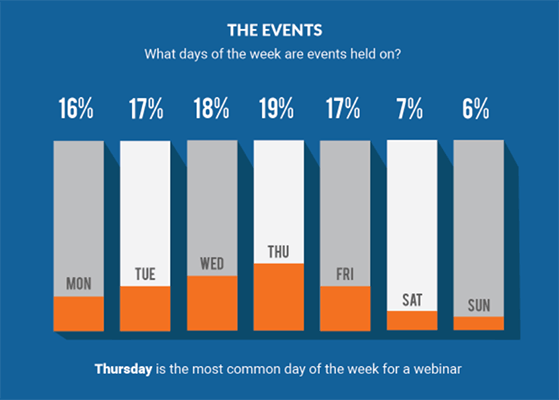
46% would hold webinars between 12 PM and 6 PM. The peak usage would be between 2 and 4 PM.
On average, a webinar will have 16 attendees.
GoTo Meeting echoed the same results. It reports that 25% of people prefer to attend webinars on Thursdays. Wednesday is at a close second at 24%. 22% said that they prefer to attend webinars on Tuesdays.
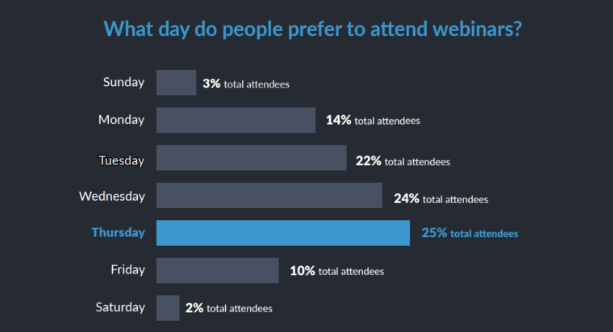
However, 16.1% of their users prefer attending meetings at 11 AM. 14.6% said they’d rather attend webinars at 2 PM. 12.9% want to attend webinars at 1 PM.
Livestorm also states that its webinar metrics also point to Wednesdays and Thursdays as the best days to host a webinar.
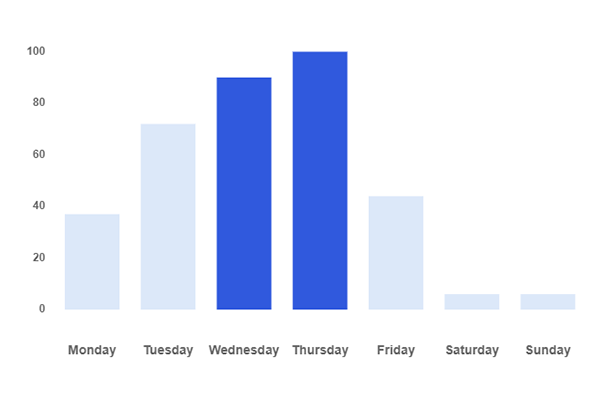
On a scale of 0 to 100 (with 100 being the highest), Thursdays scored the highest at 100 points. Wednesdays came in second at 90 points.
It’s worth remembering that due to developments in webinar software, it’s possible to run on-demand and evergreen webinars. This will allow participants to watch at a time that suits them.
Source: MegaMeeting, GoTo Meeting, Livestorm
The ideal length for a webinar is 60 minutes.
60 minutes seem to be the ideal webinar length according to webinar attendees. In fact, over 55% of webinars that are hosted on WorkCast—a webinar software—are about an hour long.
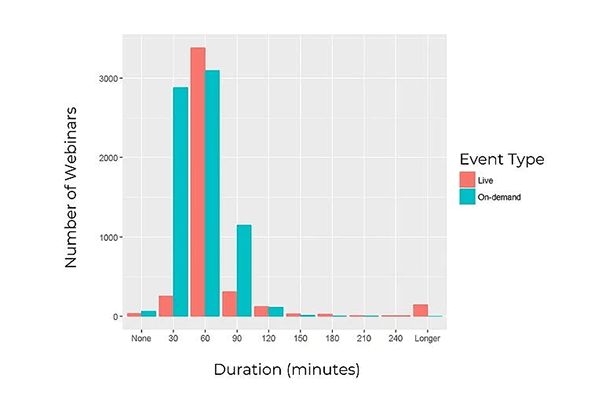
However, when it comes to on-demand content, 30 minutes seem to be the ideal length according to 39% of webinar attendees.
The same source notes that people who attend live events consume almost 4 times more content on average versus on-demand webinar attendees.
Livestorm’s webinar statistics say the same thing as it recommends webinar hosts to make their sessions 30 to 60 minutes long for maximum engagement from webinar attendees.
Source: WorkCast, Livestorm
Hosting a webinar can cost as little as $100 to as much as $3,000.
The cost of hosting a webinar will vary depending on the webinar software used among others. It’s anywhere between $100 to $3,000. While there are cheaper (or even free) options out there, these webinar software packages usually limit the number of webinar registrations to five.
Source: Blogging Wizard
Webinar attendees prefer the webinar to end with a Q&A session.
92% of webinar attendees prefer to see a Q&A session at the end of a webinar presentation. Webinar attendees prefer sessions that end in a Q&A because they get to ask those hosting webinars about things they failed to understand.
Source: Blogging Wizard
Webinar statistics for businesses
These webinar registration statistics can help businesses plan for their next session. These will show you what the most common use cases there are for webinars.
Why do people watch webinars? And what kind of webinar attendance can you expect to get?
86% use webinars for marketing purposes.
86% of survey respondents said that they use webinars for marketing and that they run up to 150 webinars in a year. 57% said that they would run up to 50 during the same period.
80% of businesses that provide training webinars would produce up to 100 per year. 20% said they would produce more than 100 during the same period. 96% stated that they have plans to increase their webinar production in the next 12 months.
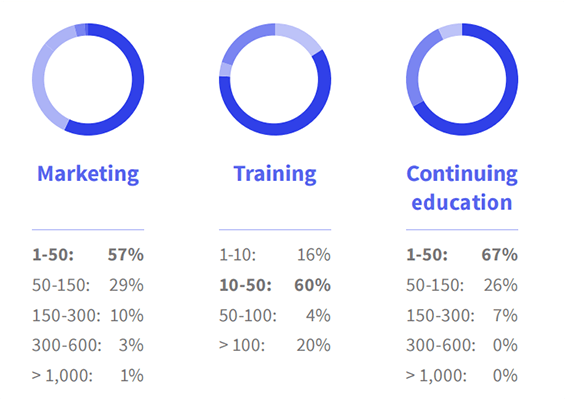
93% of users said that they use webinars to continue their education.
Source: ON24 Webinar Benchmarks Report
80% of webinar users are running Windows OS.
According to MegaMeeting, 80% of its users are running Windows OS. Only 13% are Mac users. On the mobile side, 5% are iOS users while 2% use Android.
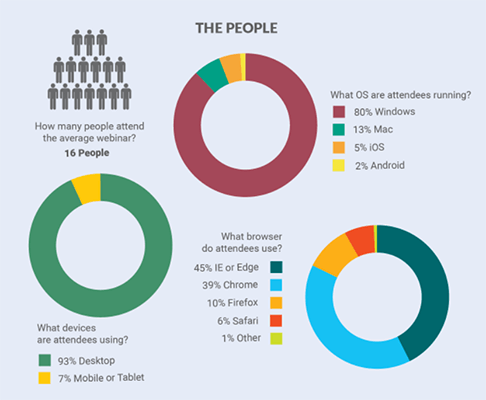
The same source said that 45% of its users logged in through Internet Explorer or Edge. Only 39% are using Google Chrome.
Source: MegaMeeting
Businesses use webinars to demonstrate customer lifecycles.
60% of businesses use webinars to move people through the customer lifecycle. That means taking a customer from a prospect to a loyal customer.
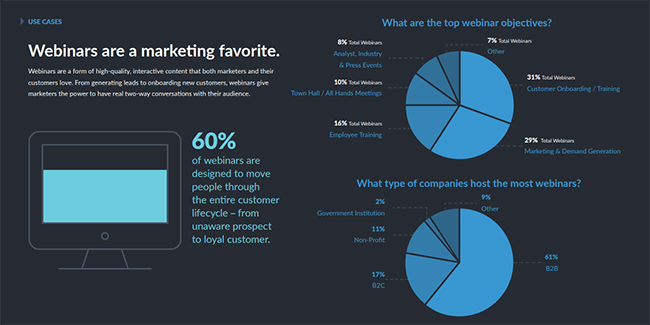
Other webinar use cases include employee training (16%), town hall meetings (10%), and press events (8%).
Blogging Wizard’s compilation of webinar statistics also reveals that 61% of companies use webinars as a content marketing tactic. That’s 1% behind infographics but well above research reports at 48%.
Source: GoTo Webinar, Blogging Wizard
26% of all webinars are produced by the software and technology sector.
26% of all business-related webinars come from the software and technology sector. 12% are from financial services. 11% comes from consulting organizations.
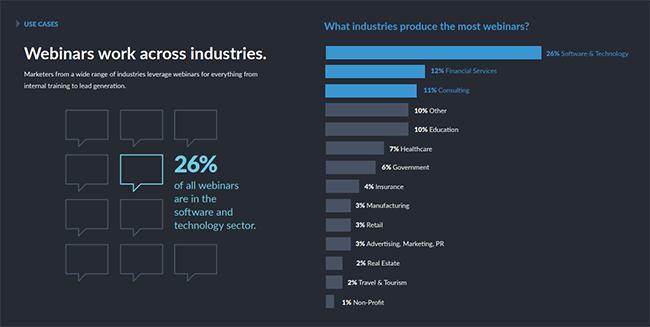
Other industries worth noting are education (10%), healthcare (7%), government (6%), insurance (4%), and manufacturing (3%).
Source: GoTo Webinar
37% of marketers don’t use webinars because of time constraints.
In a survey of marketers, 37% said that they don’t use webinars because they felt that they don’t have enough time to run webinar programs. 34% felt that it was challenging to create webinar content.
Meanwhile, 22% expressed that a webinar marketing strategy is an ineffective channel. 23% just never thought about using webinar software at all.
Source: BrightTalk
Webinar lead generation statistics
The following webinar marketing statistics will explain how effective marketing webinars can be. Should webinar marketers include this medium in their marketing strategy? What webinar metrics should they pay close attention to? Do people that watch webinars convert into qualified leads?
These webinar stats have the answer.
Best time to send webinar invites is 9am on a Tuesday.
24% of webinar registrations happen on Tuesdays. And according to GoTo Meeting, the best time to send invites is 9 AM since it gets the best response.
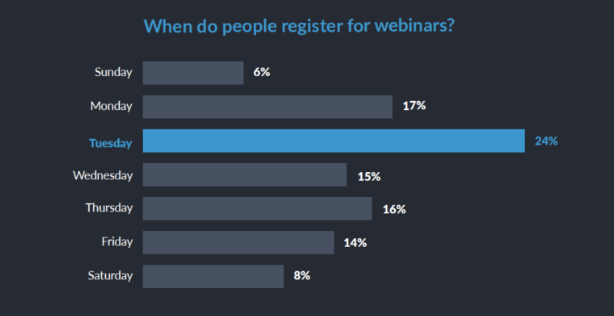
You don’t want to send your invites on Sundays. Only 6% of users send their webinar invites on Sundays.
Source: GoTo Meeting
Webinars are good for generating leads.
73% of B2B marketers said that webinars are great for generating high-quality leads. They even go on to say that webinars are a top source of leads and pipelines.
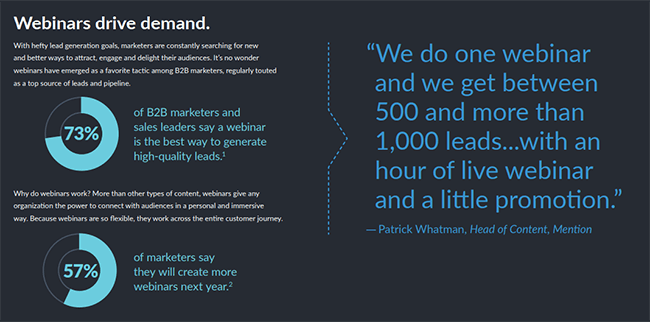
One marketer goes on to say that their company can get anywhere between 500 and 1,000 leads out of one webinar.
57% of B2B marketers said that they will create more webinars in the following year.
DemandGen notes that webinars are the top content format for marketers that want to engage leads at 48% in 2021 — this is a 15-point increase from their 2020 webinar statistics numbers.
According to a webinar statistics roundup by Blogging Wizard, 73% of B2B webinar attendees convert to leads on average. However, only 20% to 40% of B2C webinar attendees turn into leads according to the same source.
Source: GoTo Webinar, DemandGen, Blogging Wizard
The pharmaceutical industry generates the most webinar attendance.
According to webinar statistics provided by Livestorm, the pharmaceutical industry gets the highest participation rate at 63%. The advertising industry has the lowest participation rate at 33%.
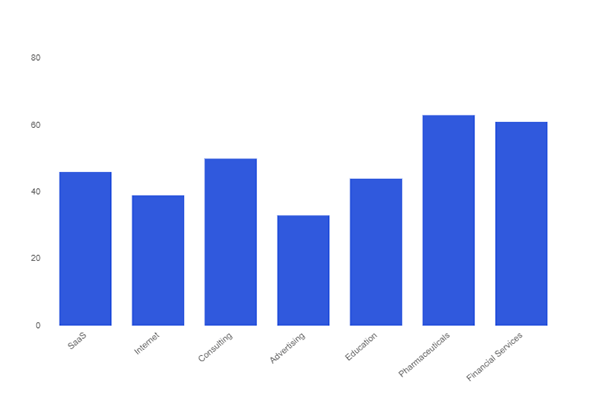
The average attendance rate that a marketer can expect with webinars is 46%.
Source: Livestorm
Webinar statistics sources
Final thoughts
There you have it, 19+ statistics all about webinars.
Webinars have grown expotentially over the past 2 years since we have had to adapt to new workstyles, with webinar content production increasing by 390% in April 2020 alone.
Hopefully these statistics have given you some insight into how you should proceed with creating your own webinars, such as Thursday being the most popular day and the preferred length being between 30-60 minutes long.
Looking for more? Check out these stats roundups:
